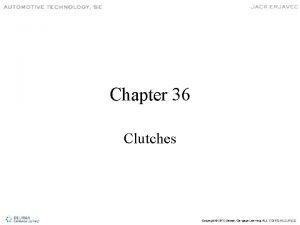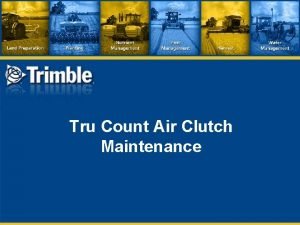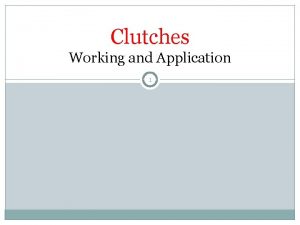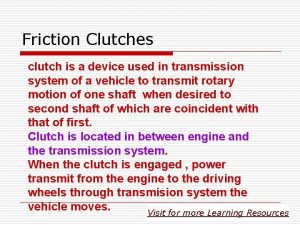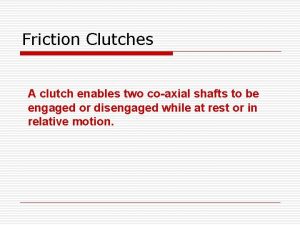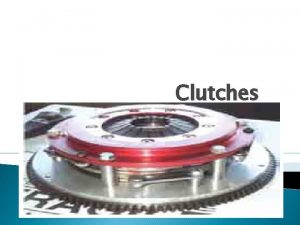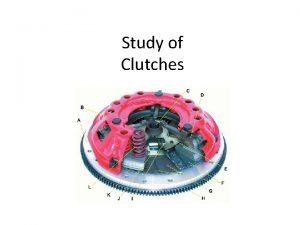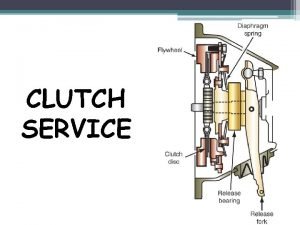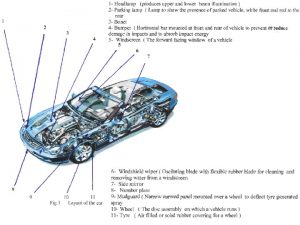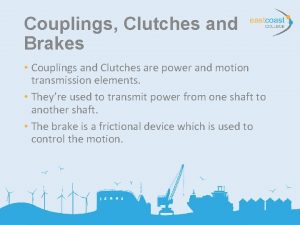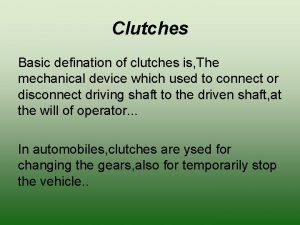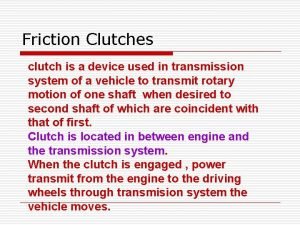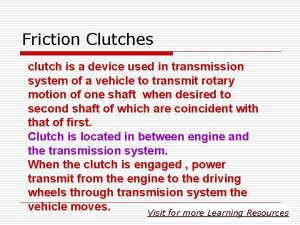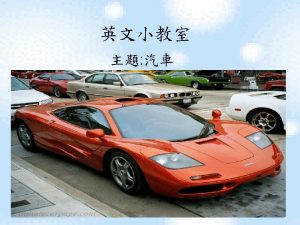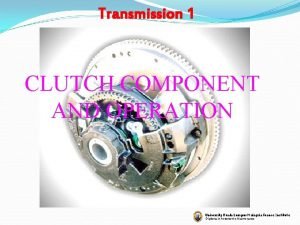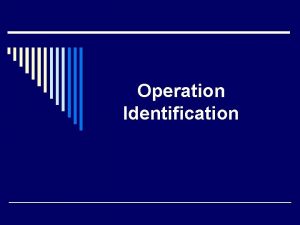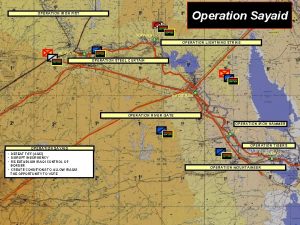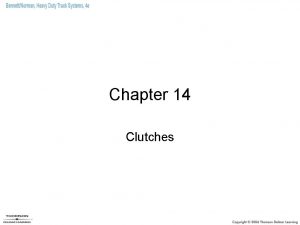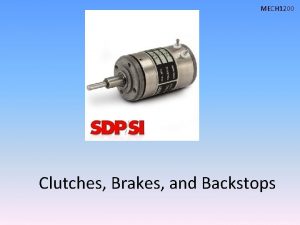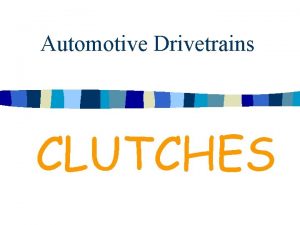Chapter 36 Clutches Clutch Components Clutch Operation The





































- Slides: 37

Chapter 36 Clutches

Clutch Components

Clutch Operation • The pressure plate is a large spring-loaded plate that engages the clutch by pressing the disc against the flywheel. • The pressure plate moves away from the flywheel when the clutch pedal is depressed.

Clutch Operation (cont’d) • The clutch release bearing is operated by the clutch linkage. • When the clutch pedal is depressed, the bearing moves toward the flywheel, depressing the pressure plate fingers and moving the pressure plate away from the clutch disc.


Dual Mass Flywheel • Used to reduce vibrations, provide for smoother shifting, and reduce gear noise.

Clutch Components (cont’d) • Clutch Disc – Is covered with friction material. – Is squeezed between the flywheel and the pressure plate. – Transmits power from engine crankshaft to transmission input shaft.


Pilot Bushing/Bearing • Supports the outer end of the input shaft. • Inside end of the input shaft is supported by a bearing in the transmission. • Since the outer end is unsupported by the transmission, the pilot bushing/bearing supports and keeps the shaft aligned.

Clutch Components (cont’d) • Pressure Plate Assembly – Squeezes clutch disc onto flywheel. – Can be engaged or disengaged. – Acts like a spring-loaded clamp. • Release Bearing – Is operated by the clutch linkage. – Presses against the pressure plate to release the clutch.

Pressure Plates

Release Bearings

Clutch Fork • Moves the release bearing back and forth during engagement and disengagement.

Clutch Linkage • Clutch linkage transfers the clutch pedal movement to the release bearing. • Mechanical clutch linkage uses shafts, levers, or a cable. • Hydraulic clutch linkage consists of a master cylinder, hydraulic tubing, and a slave cylinder.



Service Precautions • Always wear eye protection. • Use the proper equipment to remove asbestos particles and dust. • Never use compressed air to clean clutch dust. • Dispose of materials containing asbestos properly.

Service Precautions (cont’d) • Always work in a well-ventilated area. • Have a helper assist in removing a transmission. • Place the gearshift in neutral and set the parking brake when running a stationary vehicle.

Clutch Maintenance • Linkage Adjustment – Clutch pedal free play • External Linkage Lubrication – Lubricated during normal chassis lubrication – Lube sliding surfaces and pivot points – On hydraulic systems, check fluid level

Common Clutch Problems • Clutch Slippage - With the clutch engaged, engine speed increases but vehicle speed does not – Check with parking brake set, engine at 2000 rpm, transmission in third gear – Release clutch – engine should stall immediately – Before disassembly: • Check linkage • Check for worn or binding parts • Check engine mounts

Common Clutch Problems (cont’d) • Other causes for clutch slippage: – Oil-soaked or worn disc facings – Warped flywheel or pressure plate – Weak pressure plate springs – Contact between the release bearing and the fingers of the pressure plate

Drag and Binding • Dragging Clutch – Is usually caused by linkage problems, incorrect pedal adjustments, warped disc or pressure plate, a binding or seized pilot bushing/bearing, or defective clutch assembly • Binding Clutch – Is usually caused by binding linkage or cables, damaged input shaft splines, or problems with the release levers

Common Clutch Problems (cont’d) • Clutch Chatter – Definition - Shaking or shuddering when clutch is engaged. – Before Disassembly: • Check engine mounts • Check for leaks from rear main seal, transmission input shaft seal, and clutch slave cylinder

Common Clutch Problems (cont’d) • Pulsating Clutch Pedal – Is usually caused by broken or bent release levers, misaligned bell housing, or warped pressure plate, flywheel, or clutch disc • Clutch Vibrations – Are usually caused by worn engine mounts, loose bolts, excessive flywheel runout, or flywheel and/or pressure plate assembly imbalance

Common Clutch Problems (cont’d) • Clutch noises – These noises are usually caused by bad bearings or bushings – To diagnose, determine whether the noise changes with the clutch engaged or disengaged

Hydraulic-Operated Clutch Diagnosis • Soft clutch pedal or excessive pedal travel – Is usually caused by low fluid level – May be caused by a faulty master or slave cylinder • Hard pedal – Is commonly caused by binding linkage or swollen cups in the master or slave cylinder

Clutch Service • Check bell housing and all clutch parts for signs of oil leakage. • Ensure clean engine and bell housing mating surfaces. • Check for damaged or warped mounting surfaces. • Check dowels and dowel bores.

Clutch Service (cont’d) • Check flywheel runout. • Check flywheel’s ring gear teeth. • Use a clutch alignment tool during disassembly and reassembly. • Loosen and tighten pressure plate bolts according to the correct sequence. • Torque all fasteners to specifications.

Clutch Service (cont’d) • • Keep grease and dirt off friction surfaces. Check pressure plate warpage. Check release levers for wear. Inspect the release bearing. Inspect/replace the pilot bushing or bearing. Lubricate the input shaft and bearing retainer. Check pedal free play after installation.

Hydraulic-Operated Clutch Linkage Service • Check fluid level – do not overfill. • Inspect master cylinder and slave cylinder for signs of leakage. • Bleed the system if opened for component replacement.







 Chapter 36
Chapter 36 Tru count air clutch problems
Tru count air clutch problems Application of clutches
Application of clutches Classification of clutch
Classification of clutch Clutch is a device used to
Clutch is a device used to Coaxial shafts
Coaxial shafts Hát kết hợp bộ gõ cơ thể
Hát kết hợp bộ gõ cơ thể Lp html
Lp html Bổ thể
Bổ thể Tỉ lệ cơ thể trẻ em
Tỉ lệ cơ thể trẻ em Voi kéo gỗ như thế nào
Voi kéo gỗ như thế nào Chụp tư thế worms-breton
Chụp tư thế worms-breton Hát lên người ơi
Hát lên người ơi Các môn thể thao bắt đầu bằng tiếng đua
Các môn thể thao bắt đầu bằng tiếng đua Thế nào là hệ số cao nhất
Thế nào là hệ số cao nhất Các châu lục và đại dương trên thế giới
Các châu lục và đại dương trên thế giới Công thức tính độ biến thiên đông lượng
Công thức tính độ biến thiên đông lượng Trời xanh đây là của chúng ta thể thơ
Trời xanh đây là của chúng ta thể thơ Mật thư anh em như thể tay chân
Mật thư anh em như thể tay chân 101012 bằng
101012 bằng Phản ứng thế ankan
Phản ứng thế ankan Các châu lục và đại dương trên thế giới
Các châu lục và đại dương trên thế giới Thể thơ truyền thống
Thể thơ truyền thống Quá trình desamine hóa có thể tạo ra
Quá trình desamine hóa có thể tạo ra Một số thể thơ truyền thống
Một số thể thơ truyền thống Cái miệng nó xinh thế chỉ nói điều hay thôi
Cái miệng nó xinh thế chỉ nói điều hay thôi Vẽ hình chiếu vuông góc của vật thể sau
Vẽ hình chiếu vuông góc của vật thể sau Thế nào là sự mỏi cơ
Thế nào là sự mỏi cơ đặc điểm cơ thể của người tối cổ
đặc điểm cơ thể của người tối cổ V cc
V cc Vẽ hình chiếu đứng bằng cạnh của vật thể
Vẽ hình chiếu đứng bằng cạnh của vật thể Fecboak
Fecboak Thẻ vin
Thẻ vin đại từ thay thế
đại từ thay thế điện thế nghỉ
điện thế nghỉ Tư thế ngồi viết
Tư thế ngồi viết Diễn thế sinh thái là
Diễn thế sinh thái là Dạng đột biến một nhiễm là
Dạng đột biến một nhiễm là
